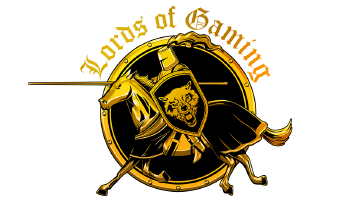
Triangle Strategy is a turn-based strategy RPG developed by Artdink and Square Enix. I’m not a fan of strategy games, as well as the game’s name, but I was a fan of the previous 2D-HD game Octopath Traveler so this seemed up my alley. Throughout this game, I experienced a very long story with many lovable characters and a brutal combat system that left me satisfied with each enemy encounter. But there’s so much more to this game than that. It is not just a retro-styled game, it’s a fully fleshed-out modern game using this style to deliver a wonderful experience.
Developer & Publisher // Square Enix, Artdink
Platforms // Switch, PC
MSRP & Release Date //$59.99, Mar 4, 2022
Reviewed On // Switch
The Three Sides of Triangle Strategy’s Story
The realm of Norzelia has known peace for three decades after the “SaltIron War”. The three kingdoms claimed control of key resources to strengthen their territory. The Duchy of Aesfrost controls iron. The Kingdom of Glenbrook controls the rivers for trading purchases. While the Holy State of Hyzante controls salt. When a new war suddenly starts, young Serenoa Wolffort and his domain of the Kingdom of Glenbrook must survive the storm and uncover the mystery of what sparked it.
The plot of Triangle Strategy is as visceral as it is meaty. In the beginning, the game’s protagonist, Serenoa, has to comply with an arranged marriage with his bride-to-be Frederica and more responsibilities for his kingdom. It’s simple at first and you get to meet a colorful cast of very memorable characters. But the serenity is shattered as quickly as you grow comfortable with it.

This new war takes you on an emotional journey as you watch the world you knew change. Witnessing characters die, the many soldiers of each kingdom dead in a pool of their own blood. It’s shocking how far the consequences of each conflict feel. As such multiple characters in the story evolve and adapt through key moments. It kept me intrigued to see how characters reacted in certain scenarios. Like an elderly member of the party lamenting over the domain’s honor being lost by agreeing to a deal with illegal goods.
The experience of the base plot of Triangle Strategy will hold your attention through its many, many chapters because of this. While also allowing you to alter it through in-game choices that may not seem important at first. But will lead to far-reaching consequences.
The Scales of Conviction
Triangle Strategy puts weight behind the choices you’ll be making in the game. When you speak to characters, sometimes you’ll be able to choose which dialogue to respond with. As simple as this sounds, however, these choices don’t just progress the conversation. Each choice is unique and lets you see how Serenoa thinks in each scenario.
For example, when Frederica asks him what her pink hair means to him, you can choose between a formal, romantic, or logical response. With each response getting a different reaction from her. As well as strengthening Serenoa’s “convictions”.

There are three convictions aligned to each response. These convictions are a metric for acquiring new characters in the game. Some require high “Morality”, high “Utility”, high “Liberty”, or a mix of all three. However, you will not be able to see your convictions clearly until you beat the game and move onto New Game+.
This is a great system and makes conversations very engaging, but having to complete the game to unlock the ability to view convictions isn’t ideal. Due to the fact that if you only chose options that aligned with Morality only you would be missing characters that require high Utility or Liberty and spend most of the new game+ trying to correct course.
The Path You Travel
Going alongside the choice system for dialogue is an equal system for choices that affect the overall story. Serenoa has the “Scales of Conviction” that allows him to fairly make choices with his comrades. You will always have seven key characters that will have their own stances on which path is the correct one to take. But Serenoa can influence each character through conversation to tilt the scales in your favor.
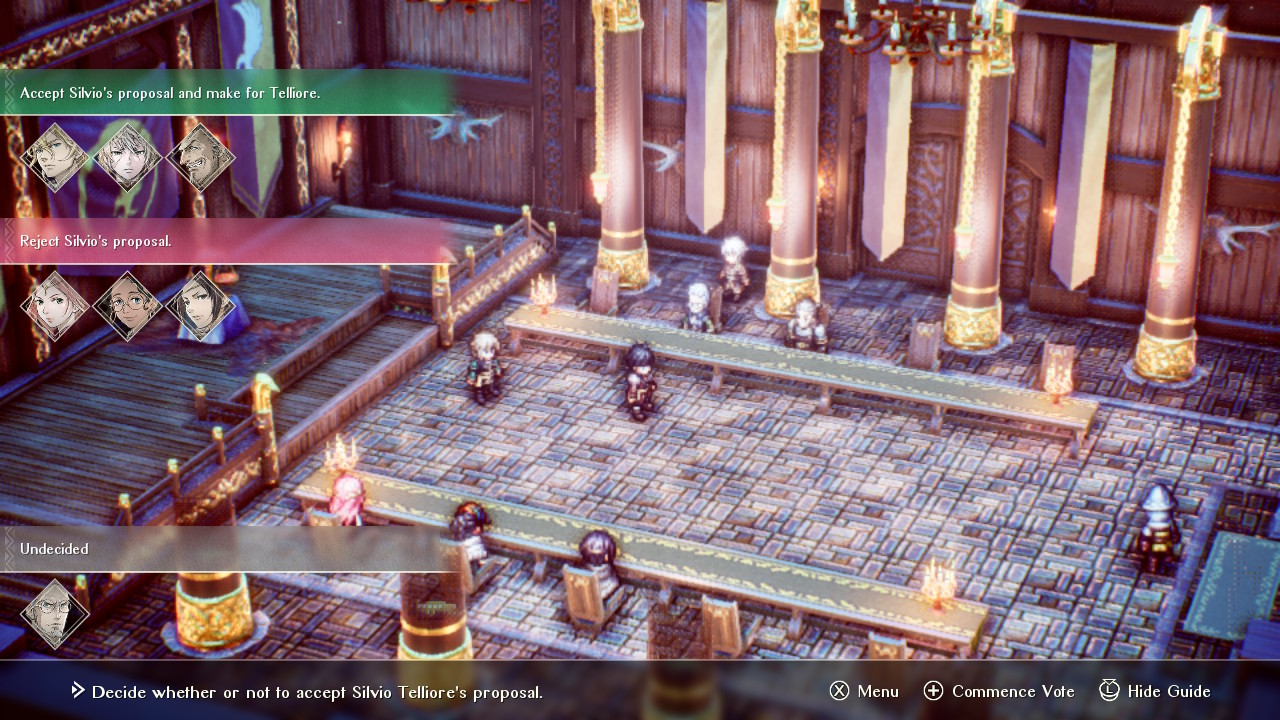
Seeing as you only need to persuade one to pick any of the paths available, there will always be a person that’s undecided on the choice to make this process easier. Certain characters will disagree with the choices you make and in certain scenarios, they will even fight you over your decision.
There is a lot of these decisions throughout the game as well. They will take you to new places and let you experience new events. As well as influencing what ending you get. Certain key events will always take place no matter what, but it was very exciting to see a system like this that does encourage multiple playthroughs to see events you miss.

An Ensemble Cast
The quantity of characters in Triangle Strategy is staggering. There are eight key characters that will be with you for most of the story. Then there’s a multitude of other characters spread throughout the world. The Archduke of Aesfrost, Gustadolph, and his two siblings. The King of Glenbrook, Regna, and his three children with one of them being a companion in the story. As well as the “Saintly Seven” of Hyzante that you encounter multiple times in the story.
All of these characters get a fair amount of screentime though. You learn their motivations, and their characterization is very impressive. None of the characters are shallow nor sound similar to each other due to their distinct personalities.
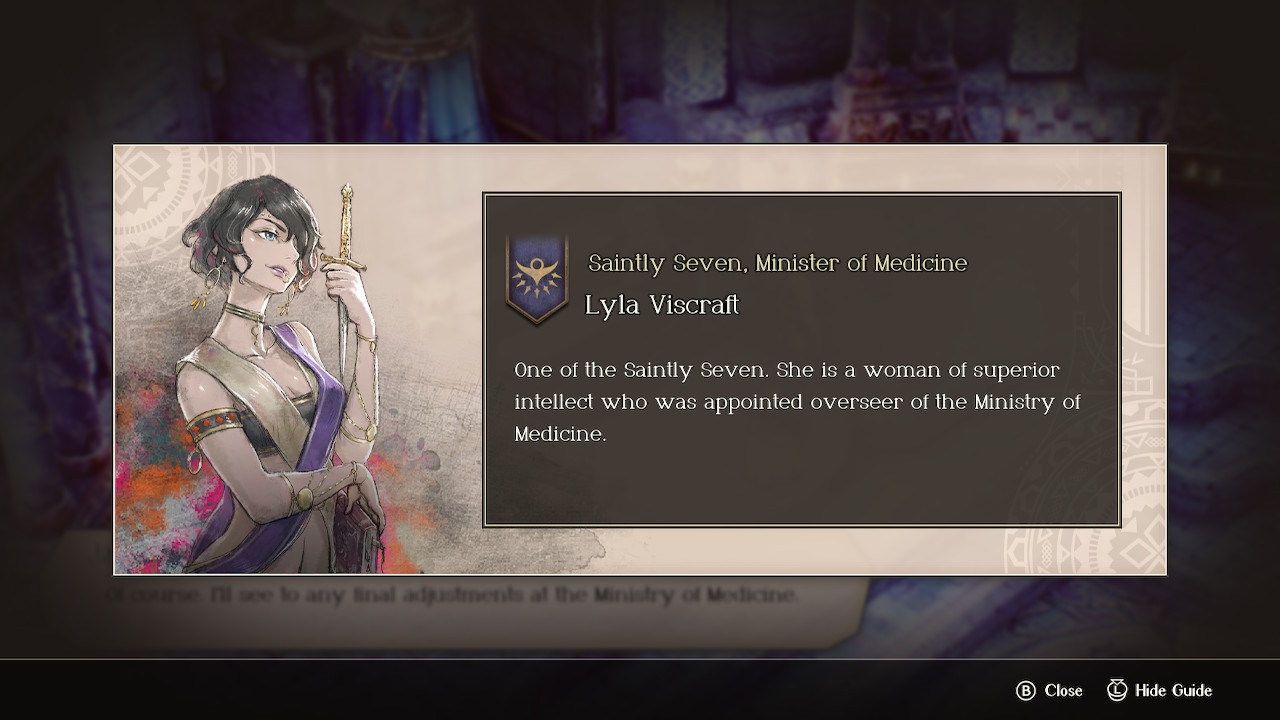
For example, Serenoa is someone who has to be calm and collected due to the expectations placed on him by his father and his domain. Frederica is a “Roselle”, a race of people as indicated by her hair that gets discriminated against. She’s shocked to be in the caring company of others and is always eager to find the root of hatred for the Roselle. While Roland, the prince of Glenbrook, is carefree and spends his time being a friend to Serenoa.
I adored seeing each and every character when they were on screen. Even the evil characters and especially the character who started the war. The way they act and how far they go was exhilarating to watch. Despite having to see them interact with each other for hours on end as dialogue in the game can feel overly written. However, I never felt the need to skip any of these moments as I would miss out on important details for the overall story.
Brutal Strategic Combat
The combat in Triangle Strategy is as slow-paced as the rest of the game. Each combat encounter will consist of you having to move characters across a big playable space turn by turn. You will always have a limited amount of characters while the enemy will have about double the amount for you to take out. During each turn, you will have to move characters near an enemy to do damage and worry about your positioning as you do.
If an enemy moves behind you they can do critical damage against your character, but you can as well. In fact, if you move a character behind an enemy and one in front of them, you will be able to perform a double attack. But be wary as enemies can do the same. Each encounter is an unforgiving chess match. There are many pawns, but almost every encounter will have bosses or unique challenges like having to defuse bombs or reach certain locations that will ramp up the difficulty and make them feel more unique.
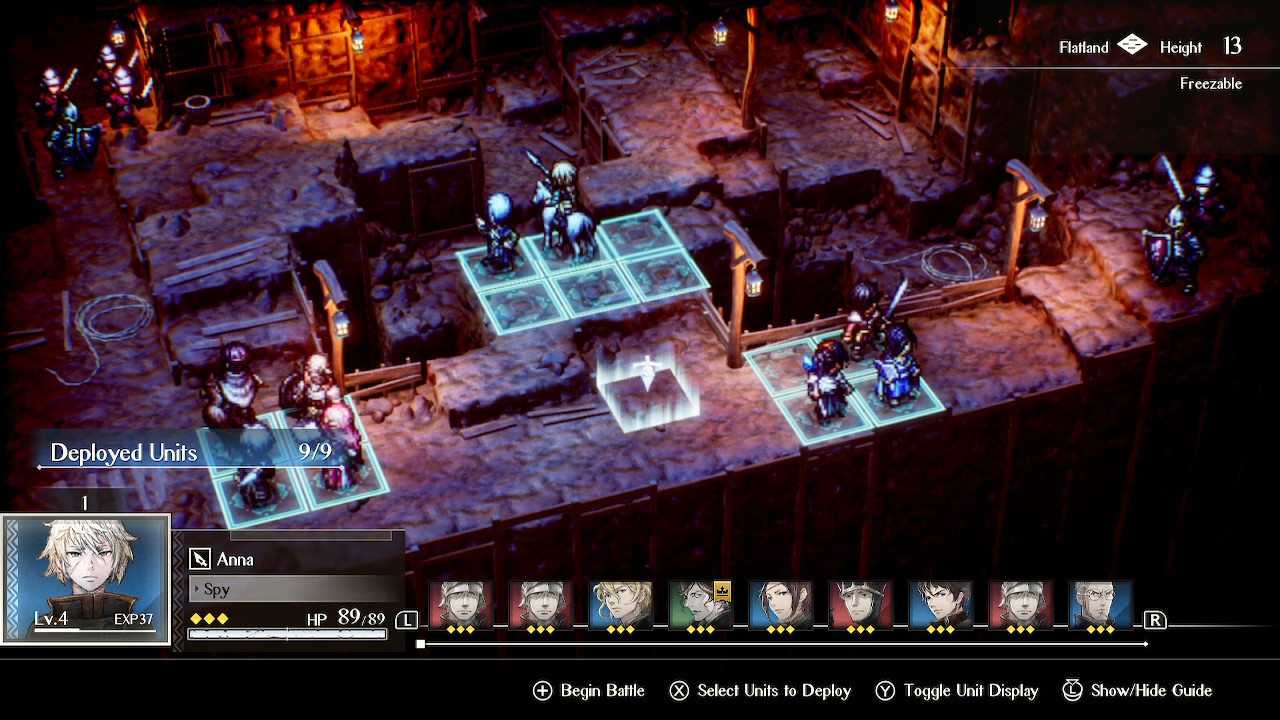
There are four difficulty modes, Very Easy, Easy, Normal, and Hard. I played through the game on easy and struggled even on that difficulty level. Some encounters were manageable, while others left with me with one or two characters. I did try encounters on the higher difficulties and constantly failed to do so.
Like Pieces On a Chess Board
Every character in Triangle Strategy will always have unique functions in combat. Serenoa is a standard knight, Frederica is a fire spell caster, Roland is on a horse and can move farther than others and hit within two squares ahead of him. Other characters like Hughette can fly to rooftops and hit enemies from below with her bow to avoid being hurt by melee enemies and do more damage to them as a result. While Anna can attack twice in the same turn and Geela can heal one character at a time, making that singular use feel important.
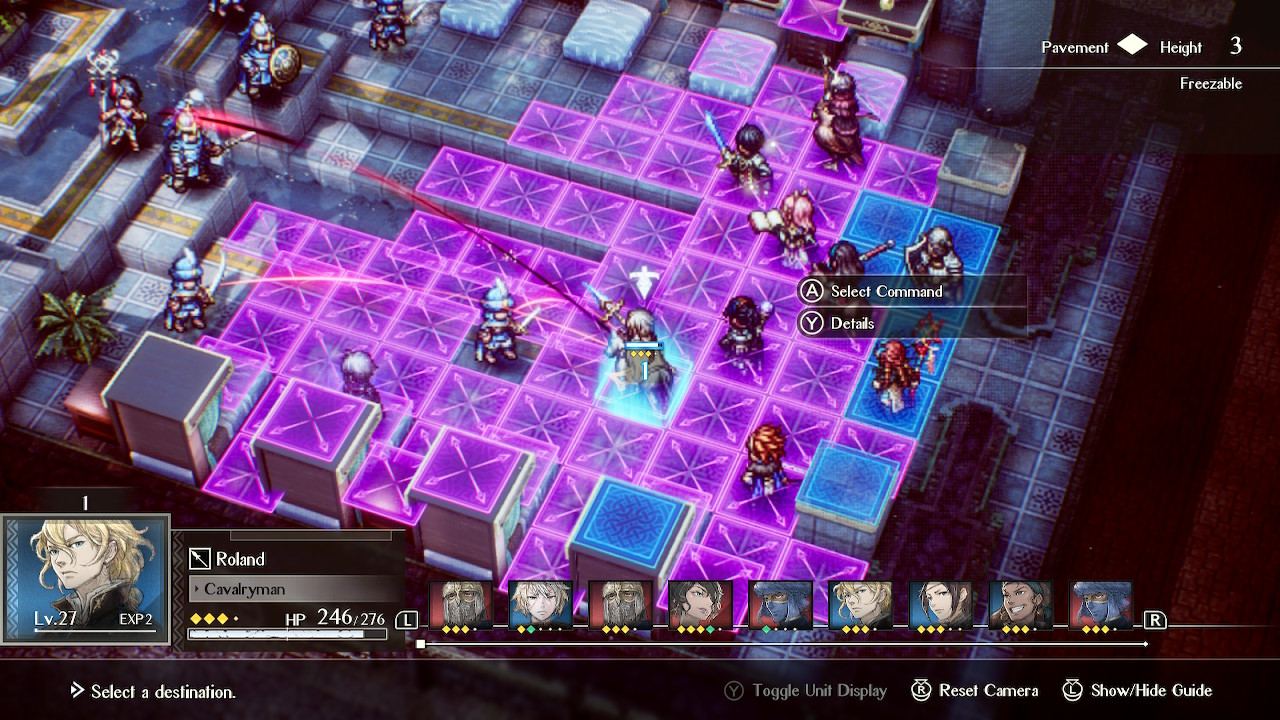
Outside of the key characters is an array of side characters that you earn through convictions. This allows you to diversify your team with whatever you need. Do you need three archers or multiple spell casters or several high health, high defense characters? The choice is yours, and you will need to cycle through characters to level them up. Since the only means of gaining experience points is by having them damage enemies or perform other actions in gameplay.
Certain combat encounters let specific characters shine too. Like on a grassy field, Frederica can light the ground on fire to make a wall to keep people from getting to her. While Ezana, a Shamaness can cast a whirlwind spell to spread the flames further. The gameplay is deep, intricate, and unforgiving but can be very fun at times if you take the time to build your team correctly.
Explore by Day, Camp by Night
The monotony of watching hours of the story and playing through long enemy encounters is broken up by small moments of exploration. You can roam around talking to various NPCs, wander in uniquely detailed houses or just find treasure. The catch here is that you can only explore these areas during certain moments in the story. Making the game feel more boxed in as a result.

However, there is one small area that will always be available to you. The encampment in Triangle Strategy hosts three vendors, a Sundry shop, a Blacksmith, and a Bartender. The Sundry shop allows you to spend “Kudos” you acquire in combat for unique abilities or rare materials to upgrade characters and their weapons. When upgrading weapons at the blacksmith, however, you are not forced to unlock anything along a fixed track of upgrades. You can choose whichever you feel is necessary at the time but the costs become greater the more you unlock.
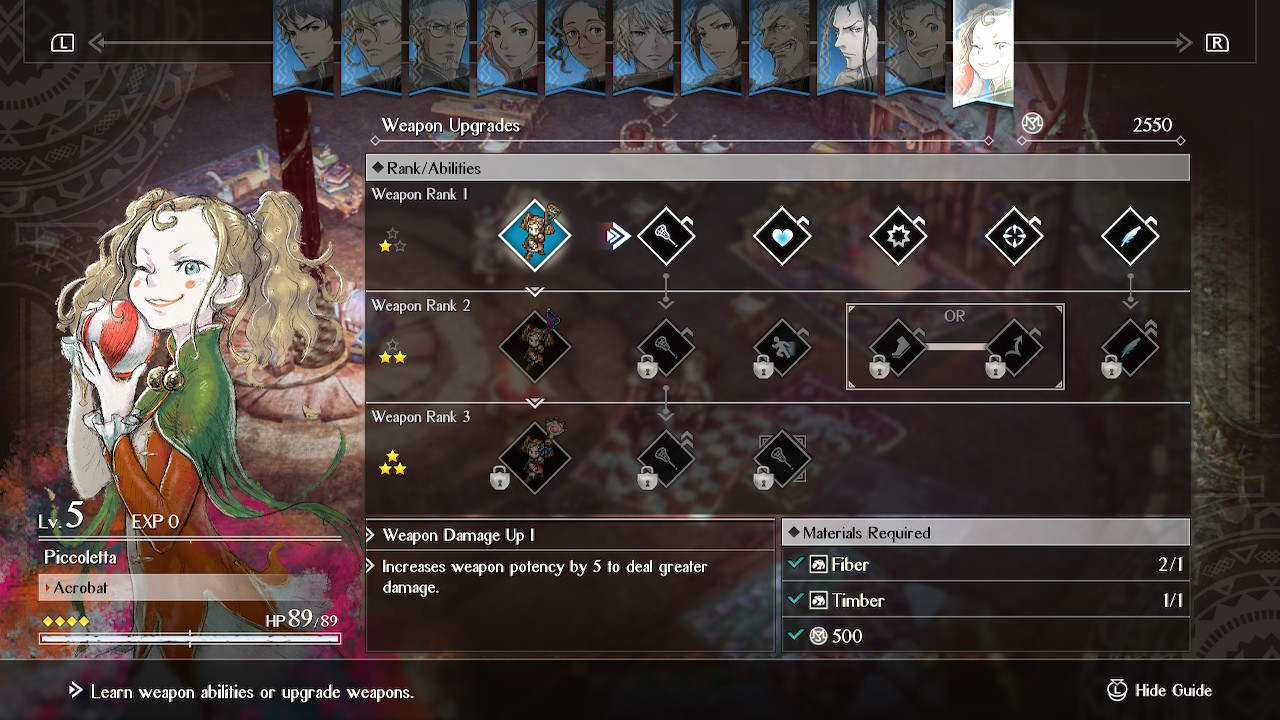
The bartender hosts a selection of optional combat encounters you can choose from to grind for materials and extra experience points if you’re under-leveled for a combat encounter in the story. The encampment is the perfect place to take a break and upgrade your characters, but the lack of exploration in the game overall is very noticeable. It doesn’t detract from the overall experience. But it would have been nice to explore some of the unique set pieces in the game at my leisure.
Technical Performance of Triangle Strategy
I played Triangle Strategy in docked mode primarily and the game ran fairly well. I can not say the same for handheld mode as the game was very blurry, but both modes never had severe framerate drops. However, the “Battle Begins” screen never looked like it flowed correctly. The game according to my screenshots used in this review only runs at 720p resolution. But the game never had any bugs, it never froze, or crashed or glitched out at any point. It was squeaky clean, to say the least.
The game’s UI is also very simple to learn. You will always have a guide at the bottom of your screen to tell you which button does what. As well as a simple menu for your inventory, a settings menu with a lot you can change. Like in Octopath Traveler you could notice a brown border at the edges of your screen. That is also present in Triangle Strategy but you can turn it off. As well as have standard options to lower voice, music, or sound effect audio to your liking.
Going from story missions is easy as you have a mouse cursor and a very simple map to navigate with a big glowing icon for the next story mission. It is very easy to pick up as a result and you will always know where something is due to its tutorials in the beginning.
Graphics, Music, and Voice Acting
Triangle Strategy uses the 2D-HD style for its entire game and it is absolutely breathtaking to look at it. Every scene in the game is thoroughly detailed. From the flames on sconces and torches, the racks of weapons, the different flags for each kingdom, and the scope of the archive in Aesfrost were all wonderful sights. Even though in certain scenes it can look pretty “off”.

There is a scene when you’re on a bridge and if you pan the camera you can see where the bridge ceases to exist. Even when characters pop into existence from that void. As well as being able to see the world map around a playable space.
The music, however, does not falter at all. It feels grand and patient while fitting into every scene. Boss battles depending on the context of the story leading into them. Can have energetic or somber vibes, it’s a wonderful touch that adds so much to the battles. All of this is complemented well by the voice acting for each character.

The English voice acting for JRPGs can either be hit or miss. I never felt the need to change the dub and I could tell each voice actor was very into their character. Especially “Dragan” who gets drunk in one scene and I could hear the sheer joy of the voice actor shine through. Even though characters like Geela can sound dull or Cordelia can sound very annoying. The good voice acting definitely outweighs the subpar ones.
Final Thoughts on Triangle Strategy
The experience provided in Triangle Strategy is one you should not miss. Its grand story with excellent writing that changes the spelling of words like “jail” to “gaol” and domain to “demesne” left me wanting to replay it immediately after experiencing the ending I got. The brutal yet satisfying combat with so many unique characters fundamentally change how an encounter plays out. As well as the gorgeous sights and sounds of the game with wonderful voice acting that suck me in and keep me in the realm of Norzelia. This game is worth every penny and the thirty hours and more of its wonderful experience.
Triangle Strategy is available now for $59.99 on the Nintendo Switch. With a demo that you can download to get a taste of the game.
